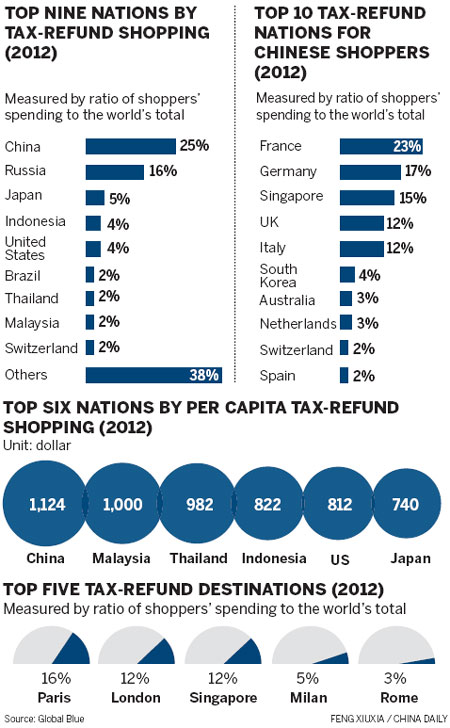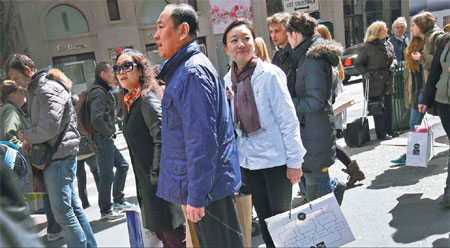Shoppers' top destinations
Updated: 2013-04-12 08:26
By Gao Yuan (China Daily)
|
|||||||||||
|
More than 80 percent of Chinese tourists see shopping as a vital part of their overseas trips. Provided to China Daily |
But e-commerce remains both good and bad in battle among high street stores
European nations were the most favorite shopping destinations for Chinese buyers in 2012 and they are set to spend even more shopping overseas, according to a report by Global Blue, a tourism shopping service provider.
Chinese shoppers spent a record 3 billion euros on duty-free shopping in 2012, an increase of nearly 60 percent year-on-year, according to Nyon, a Switzerland-based company. The figure could see a 20 to 25 percent growth in 2013, it adds.
The amount only included transactions handled by Global Blue.
"China represented a quarter of total transactions for us. The nation is the source of the world's largest number of travelers," says Arjen Kruger, executive vice-president and chief marketing officer of Global Blue.
The company report showed more than 80 percent of Chinese tourists see shopping as a vital part of their overseas trips.
Watches and jewelry were among the favorite items for Chinese shoppers, followed by fashion and lifestyle items.
Along with the Chinese government's intensified battle against bribery and its advocacy of a frugal lifestyle, analysts say the government's move will, to some extent, deter newly rich Chinese from spending excessively on luxury goods such as watches and jewelry.
However, Kruger believes it is still too early to assess the effect on the shopping industry.
"The actual impact may not show itself in the upcoming quarters," he says.
First choice
European countries were the top options for Chinese shoppers, says the report. Most Chinese tourists chose to visit France, Germany, Italy and the United Kingdom in 2012.
The number of Chinese tourists going to the United States accounted for about a quarter of those who visited European countries.
Although the United States government started to lure international travelers by pushing its tourism industry, Europe will remain the top destinations for Chinese travelers.
France was the top choice for global travelers but Chinese people are especially fond of going to Germany than shoppers from other regions, according to Kruger.
In addition to the fact that Chinese buyers are "very much appreciated", the quality of German goods and strong economic ties between the two nations also helped to boost Chinese people's spending in the European country.
Furthermore, the minimum amount that shoppers have to spend in order to enjoy tax benefits in Germany is significantly lower than in other countries, a hidden factor that may boost spending.
Any purchase above 25 euros qualifies for a tax refund in Germany. Overseas travelers have to spend about 250 euros on each purchase in order to enjoy a refund in Switzerland, Kruger says.
"It does not necessarily have to be goods with expensive price tags for Chinese shoppers. Less-expensive items could also have an accumulated impact on total spending," he says.
Germany's role as an important entry and exit port in Europe also attracted a large number of Chinese tourists.
The country has two major international airports in Munich and Frankfurt. Berlin will become a third major hub for Chinese tourists to enter Europe.
The average transaction size for Chinese shoppers was 875 euros last year, the highest among all nationalities, according to Global Blue. The second highest spenders were Thais, who on average spent 765 euros.
"Most of the top spenders in the past were visitors from Asian countries including Malaysia, Japan and Singapore. It reflected the overall economic development in that region," says Kruger.
Because expenses such as traveling and hotels do not include tax refunds, it is difficult to estimate the total spending of Chinese tourists, he adds.
Traveling behavior
It is easy to tell Chinese travelers from other Asian nationalities because Chinese people tend to travel in groups.
Although the number of independent Chinese travelers surged over the past decade, roughly 60 to 70 percent of Chinese shoppers travel in groups, says Kruger, adding the situation is very likely to continue over the next decade or so.
"If the visa process in some European nations can be simplified, it will certainly attract more Chinese travelers in the future," he adds.
Worries remain that Chinese people visiting Europe may spend less because of the thriving e-commerce business in China, which may offset Chinese people's purchasing power overseas.
"There is a big difference between e-commerce and physical-world purchasing. The price point is much lower online than in brick-and-mortar stores but the buyers are not able to feel and touch the item that they intend to buy," says Kruger.
The experiential factor also plays an important role when people are buying luxury goods, he adds. "To be able to purchase something original, where it has been manufactured, offers high-end buyers the opportunity to experience the craftsmanship and eliminate any possibilities of buying a counterfeit product."
In the long run, e-commerce will have a positive effect on brick-and-mortar shopping because the Internet allows people to see more items and services and destination information.
Such information will increase people's appetite to visit and look at the products where they originated, he says.
"The growing size of the middle class in China will benefit outbound traveling," Kruger adds.
Asian destinations will become more popular in the next five to 10 years for first-time and second-time travelers because such trips are usually less expensive, he says.
gaoyuan@chinadaily.com.cn

(China Daily 04/12/2013 page22)
Today's Top News
List of approved GM food clarified
ID checks for express deliveries in Guangdong
Govt to expand elderly care
University asks freshmen to sign suicide disclaimer
Tibet gears up for new climbing season
Media asked to promote Sino-Indian ties
Shots fired at Washington Navy Yard
Minimum growth rate set at 7%
Hot Topics
Lunar probe , China growth forecasts, Emission rules get tougher, China seen through 'colored lens', International board,
Editor's Picks

|

|

|

|

|

|






